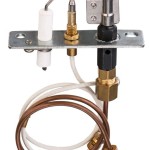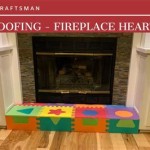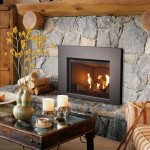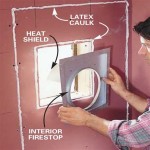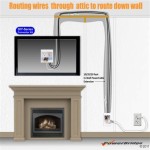Propane Fireplace Tank Installation: A Comprehensive Guide
Propane fireplaces offer a convenient and efficient heating solution for homes, providing the ambiance of a traditional fireplace without the mess and maintenance associated with wood-burning alternatives. A crucial component of any propane fireplace system is the propane tank, which serves as the fuel source. Proper installation of the propane tank is paramount to ensure safe and reliable operation of the fireplace. This article provides a detailed guide to propane fireplace tank installation, covering essential considerations, steps, and safety precautions.
Before undertaking any propane tank installation, it is imperative to consult and adhere to all applicable local, regional, and national codes and regulations. These regulations are in place to protect individuals and property, and compliance is non-negotiable. Contacting the local fire marshal or building department is highly recommended to obtain the necessary permits and ensure the installation meets all requirements. Furthermore, engaging a qualified and licensed propane professional is strongly advised, as they possess the expertise and experience to perform the installation safely and correctly. Improper installation can lead to gas leaks, explosions, and other hazardous situations.
Understanding Propane Tank Types and Sizes
Propane tanks are available in various sizes and configurations, each suited for different applications and consumption rates. For residential fireplaces, the most common tank types are portable cylinders and larger, stationary tanks. Portable cylinders, typically 20-pound or 30-pound tanks, are suitable for smaller fireplaces or supplemental heating. They are relatively easy to transport and refill, but require more frequent refills depending on usage.
Stationary tanks, ranging in size from 120 gallons to 1000 gallons or more, are designed for larger homes or properties with higher propane demand. These tanks are typically installed above ground or underground, offering a larger fuel capacity and requiring less frequent refills. Selecting the appropriate tank size depends on several factors, including the size of the fireplace, the frequency of use, the climate, and the overall heating needs of the property. Consulting with a propane professional is essential for determining the optimal tank size for a specific application.
Tank material is another consideration. Tanks are typically made of steel or aluminum. Steel tanks are more common and generally less expensive, while aluminum tanks are lighter and more resistant to corrosion. The choice of material often depends on budget and environmental factors.
The placement of the tank is also a critical decision. Above-ground tanks require sufficient clearance from buildings, property lines, and sources of ignition. Underground tanks offer aesthetic advantages and are less susceptible to weather-related damage, but require more extensive installation and specialized equipment.
Step-by-Step Installation Process
The installation process will vary depending on the type of tank being installed (portable vs. stationary, above-ground vs. underground). However, the following steps outline the general procedure for installing a propane fireplace tank:
1. Site Preparation: Thoroughly inspect and prepare the installation site. Ensure the area is level, free of debris, and adequately ventilated. For above-ground tanks, a concrete pad or other stable foundation is required to prevent settling and ensure proper support. For underground tanks, excavation will be necessary, following all local codes and regulations regarding depth and proximity to other utilities.
2. Tank Placement: Carefully position the tank on the prepared foundation or in the excavated area. Ensure the tank is oriented correctly, with the fill valve and pressure relief valve accessible and unobstructed. Maintain the required clearances from buildings, property lines, and other potential hazards, as specified by local codes and regulations.
3. Leak Testing: Before connecting any piping or appliances, perform a thorough leak test of the tank. Apply a leak detection solution to all fittings and connections, and inspect for any signs of bubbling, which indicates a leak. Repair any leaks immediately before proceeding.
4. Piping Installation: Install the propane piping from the tank to the fireplace, using approved materials and techniques. Typically, copper or black iron pipe is used for propane gas lines. Ensure the piping is properly sized to accommodate the flow rate required by the fireplace. All joints and connections should be securely tightened and leak-tested. The piping should be protected from physical damage and corrosion, and properly supported to prevent sagging or strain.
5. Regulator Installation: Install a pressure regulator near the tank to reduce the high-pressure propane gas to a safe and usable pressure for the fireplace. The regulator must be compatible with the tank and fireplace, and properly adjusted to the required outlet pressure. Pressure regulators are essential for maintaining consistent gas flow and preventing over-pressurization of the fireplace system.
6. Appliance Connection: Connect the propane piping to the fireplace, using approved fittings and techniques. Ensure the connection is secure and leak-tested. Follow the fireplace manufacturer's instructions for gas connection and startup procedures.
7. System Testing: After completing the installation, perform a comprehensive system test to ensure the fireplace is operating correctly and safely. Check the flame appearance, gas pressure, and venting system. Inspect for any leaks or malfunctions. Address any issues promptly and thoroughly before placing the fireplace into service. A qualified propane professional should conduct this final inspection.
8. Backfilling (for Underground Tanks): If installing an underground tank, backfill the excavated area with suitable material, compacting the soil around the tank to provide support and prevent settling. Ensure the tank and piping are protected from damage during backfilling. Mark the location of the tank with appropriate signage or markers to prevent accidental digging or damage in the future.
Key Safety Considerations
Propane is a flammable gas, and safety must be the top priority during all phases of tank installation. The following safety considerations are crucial:
1. Leak Detection: Propane has a distinctive odorant added to it, which allows for easy detection of leaks. If you smell propane, immediately evacuate the area and contact the fire department or a qualified propane professional. Do not use any electrical devices or open flames, as they could ignite the gas.
2. Ventilation: Ensure adequate ventilation around the tank and fireplace, especially if the tank is located indoors or in an enclosed space. Propane is heavier than air and can accumulate in low-lying areas, creating a fire or explosion hazard. Proper ventilation helps to dissipate any leaked gas and prevent dangerous concentrations.
3. Clearances: Maintain adequate clearances between the tank and any sources of ignition, such as open flames, electrical equipment, or heat sources. Follow all local codes and regulations regarding minimum clearances. Clearances are designed to prevent accidental ignition of propane gas.
4. Tank Maintenance: Regularly inspect the tank, piping, and fittings for signs of damage, corrosion, or leaks. Replace any damaged or worn components promptly. Keep the area around the tank free of debris and vegetation. Regular maintenance helps to ensure the safe and reliable operation of the propane system.
5. Professional Inspection: Schedule regular inspections of the propane system by a qualified propane professional. These inspections can identify potential problems before they become serious safety hazards. A trained technician can assess the condition of the tank, piping, regulator, and other components, and recommend any necessary repairs or replacements.
6. Emergency Procedures: Familiarly know with emergency procedures in the event of a propane leak or fire. Know the location of the main gas shut-off valve and how to operate it. Have a fire extinguisher readily available and know how to use it. Understand the evacuation routes and procedures for your property.
7. Regulatory Compliance: Continuously ensure compliance with all applicable local, regional, and national codes and regulations regarding propane tank installation and operation. These regulations are in place to protect public safety and prevent accidents. Staying informed about the latest regulations is essential for maintaining a safe and compliant propane system.
Following these guidelines and working with qualified professionals ensures a safe and efficient propane fireplace tank installation, providing reliable heating and ambiance for years to come.

Installing A Gas Range With Portable Propane Tanks Will It Work

Propane Tank Installation Western Massachusetts George

Why Install A Propane Fireplace Paraco Gas

Propane Tank Installation For Home

Propane Plus Tank Sizes Above Or Underground Installation

General Guidelines For Propane Tank Placement Indoor Comfort Marketing

How To Propane Fireplace Gas Line Installation

Propane Fireplace Installation Bucks County Gastec

Residential Propane Tanks What Size Tank Do You Need

How Much Does A Propane Tank Installation Cost 2024
Related Posts

